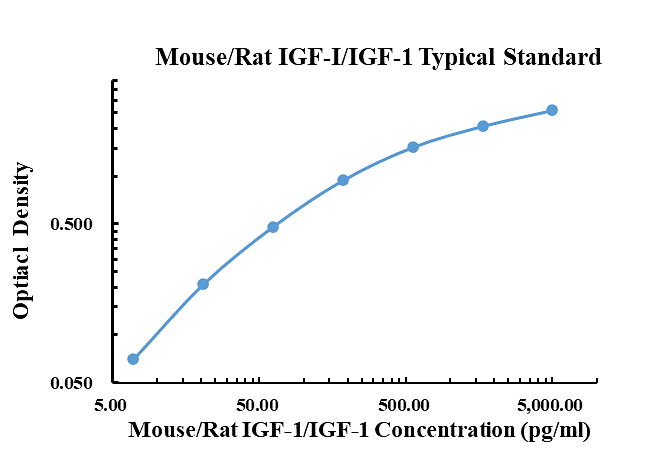Mouse/Rat IGF-I/IGF-1 enzyme-linked immunoassay kit
| Specification | 96 Test |
|---|---|
| Sensitivity | 1.76 pg/ml (50 μl);3.43 pg/ml (10 μl) |
| Standard Curve Range | 6.86~5000 pg/ml |
| Standard Curve Gradient | 7 Points/3 Folds |
| Number of Incubations | 2 |
| Detectable sample | Liquid phase sample of soluble substances. For example: serum, plasma, cell culture supernatant, tissue grinding liquid, etc. |
| Sample Volume | 50 μl/10 μl |
| Type | Fully Ready-to-Use |
| Operation Duration | 120min |

| pg/ml | O.D. | Average | Corrected | |
|---|---|---|---|---|
| 0.00 | 0.0647 | 0.0635 | 0.0641 | |
| 6.86 | 0.1385 | 0.1303 | 0.1344 | 0.0703 |
| 20.58 | 0.2735 | 0.2724 | 0.2730 | 0.2089 |
| 61.73 | 0.5618 | 0.5279 | 0.5449 | 0.4808 |
| 185.19 | 1.0550 | 0.9549 | 1.0050 | 0.9409 |
| 555.56 | 1.6270 | 1.5390 | 1.5830 | 1.5189 |
| 1666.67 | 2.2390 | 2.0130 | 2.1260 | 2.0619 |
| 5000.00 | 2.6320 | 2.6820 | 2.6570 | 2.5930 |
Precision
| Intra-assay Precision | Inter-assay Precision | |||||
| Sample Number | S1 | S2 | S3 | S1 | S2 | S3 |
| 22 | 22 | 22 | 6 | 6 | 6 | |
| Average(pg/ml) | 119.3 | 509.0 | 1409.9 | 109.9 | 510.1 | 1498.1 |
| Standard Deviation | 8.2 | 39.3 | 109.4 | 5.4 | 27.0 | 100.4 |
| Coefficient of Variation(%) | 6.9 | 7.7 | 7.8 | 4.9 | 5.3 | 6.7 |
Intra-assay Precision (Precision within an assay) Three samples of known concentration were tested twenty times on one plate to assess intra-assay precision.
Inter-assay Precision (Precision between assays) Three samples of known concentration were tested six times on one plate to assess intra-assay precision.
Spike Recovery
The spike recovery was evaluated by spiking 3 levels of Mouse/Rat IGF-I/IGF-1 into health mouse serum sample. The un-spiked serum was used as blank in this experiment.
The recovery ranged from 94% to 105% with an overall mean recovery of 101%.
Sample Values
| Sample Matrix | Sample Evaluated | Range (ng/ml) | Detectable (%) | Mean of Detectable (ng/ml) |
|---|---|---|---|---|
| Serum | 30 | 4.93-460.32 | 100 | 135.06 |
Serum/Plasma – Thirty samples from apparently healthy mice/rats were evaluated for the presence of IGF-I/IGF-1 in this assay. No medical histories were available for the donors. n.d. = non-detectable. Samples measured below the sensitivity are considered to be non-detectable.
Product Data Sheet
Background: IGF-I/IGF-1
IGF-I receptor is a disulfide-linked heterotetrameric transmembrane protein consisting of two alpha and two beta subunits. Both the alpha and beta subunits are encoded within a single receptor precursor cDNA. The proreceptor polypeptide is proteolytically cleaved and disulfide-linked to yield the mature heterotetrameric receptor. The alpha subunit of IGF-I receptor is extracellular while the beta subunit has an extracellular domain, a transmembrane domain and a cytoplasmic tyrosine kinase domain. The IGF-I receptor is highly expressed in all cell types and tissues.
IGF-II R is a type I transmembrane glycoprotein that contains a 2,264 amino acid (aa) extracellular region, a 23 aa transmembrane segment segment and a 124 aa cytoplasmic tail. IGF-II R regulates many diverse biological functions that range from intracellular trafficking to the internalization of extracellular factors and modulation of cellular responses. It delivers newly synthesized M6P-tagged lysosomal enzymes from the trans-golgi network to endosomes, and facilitates the clearance of extracellular lysosomal and matrix degrading enzymes by internalization into clathrin-coated vesicles and delivery into endosomes. With respect to IGF-II biology, It would appear that IGF-II R is principally a regulator of local IGF-II levels, targeting IGF-II for destruction in lysosomes.
The heterotetrameric receptors for insulin (INS R) and IGF-I (IGF-I R) are receptor tyrosine kinases that consist of two ligandbinding alpha subunits and two beta subunits. Ligand binding induces autophosphorylation on multiple tyrosine residues of beta subunits. Phosphorylation of Tyr1162 and 1163 on INS R and Tyr1135 and 1136 on IGF-I R stimulates intrinsic kinase activity.

